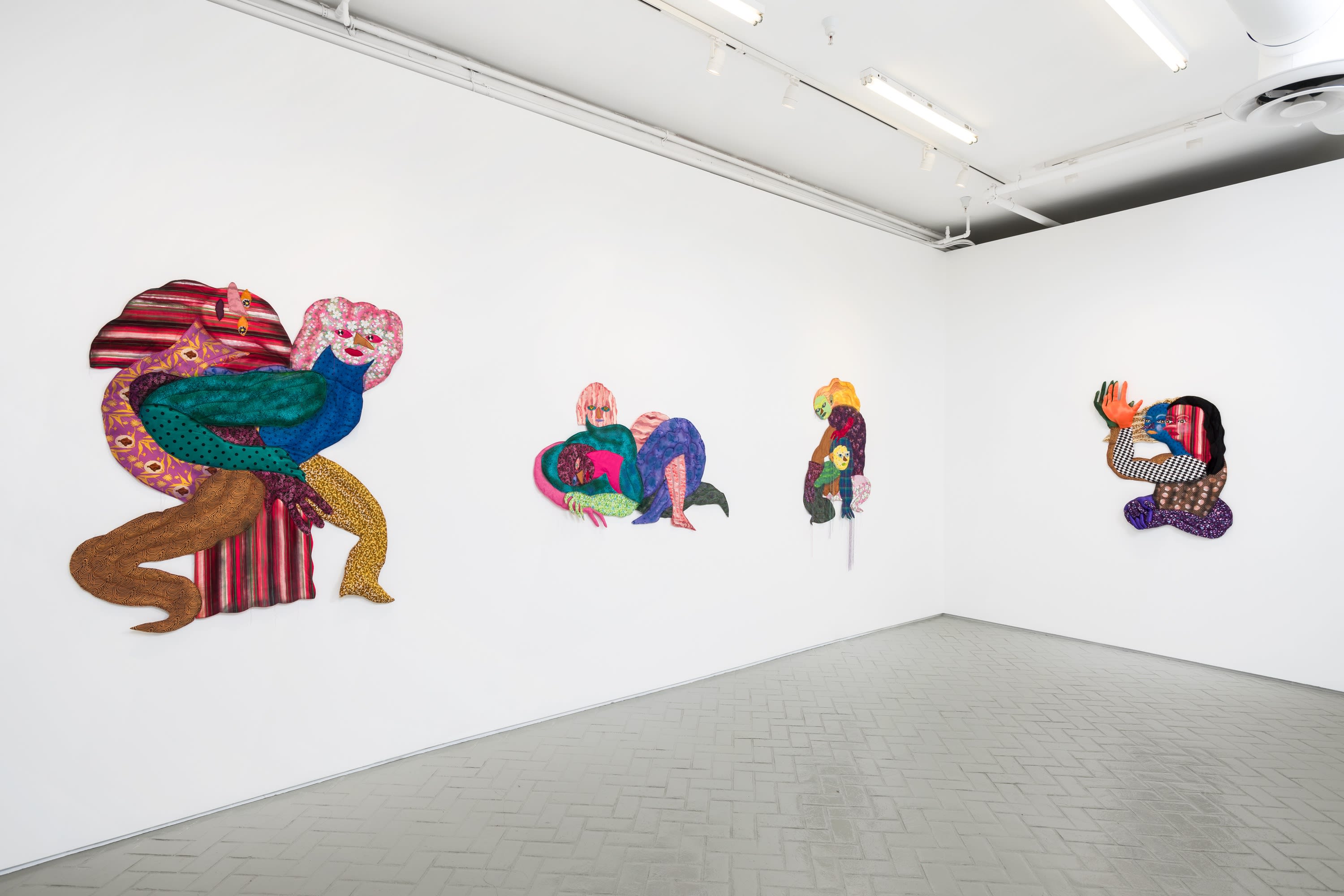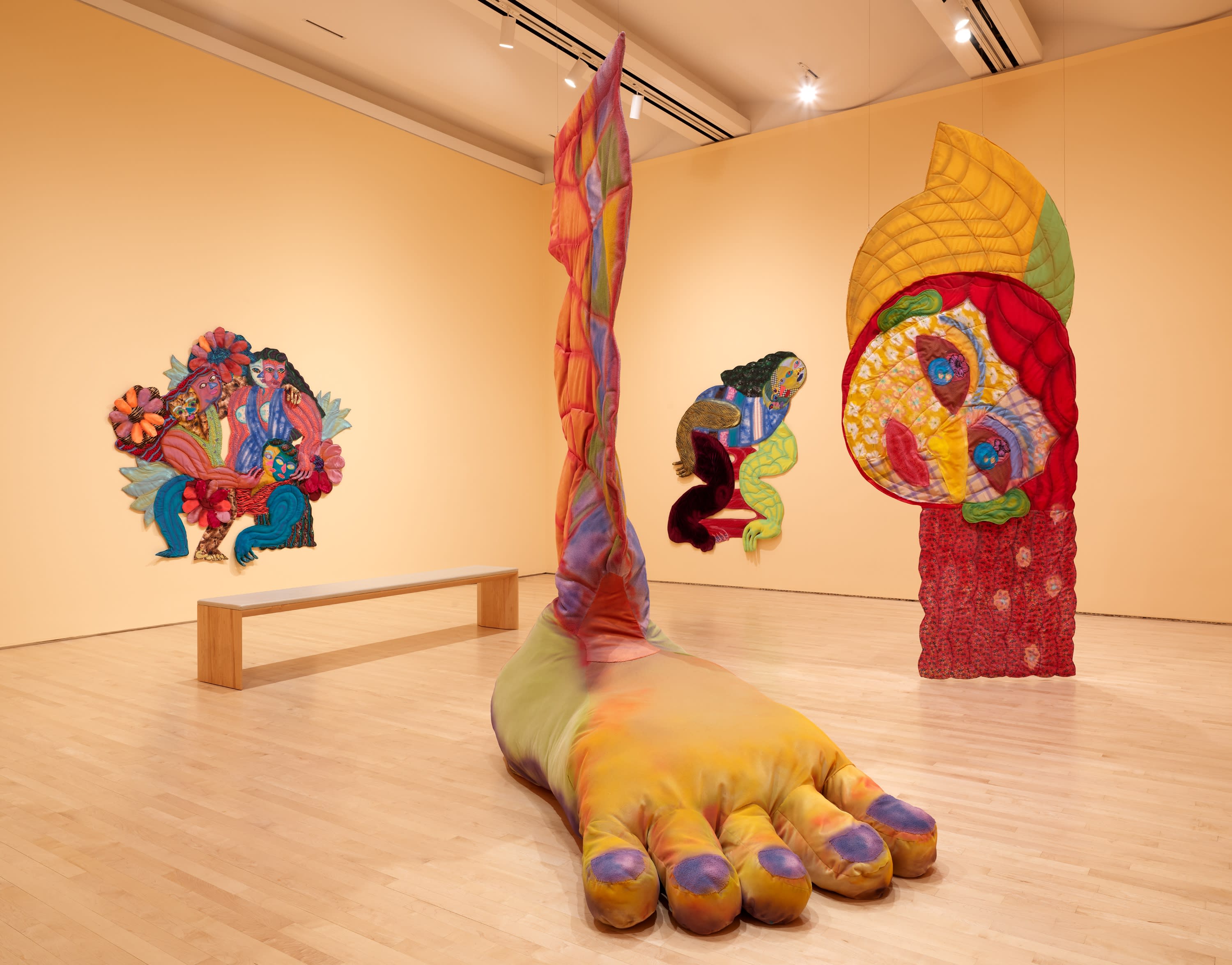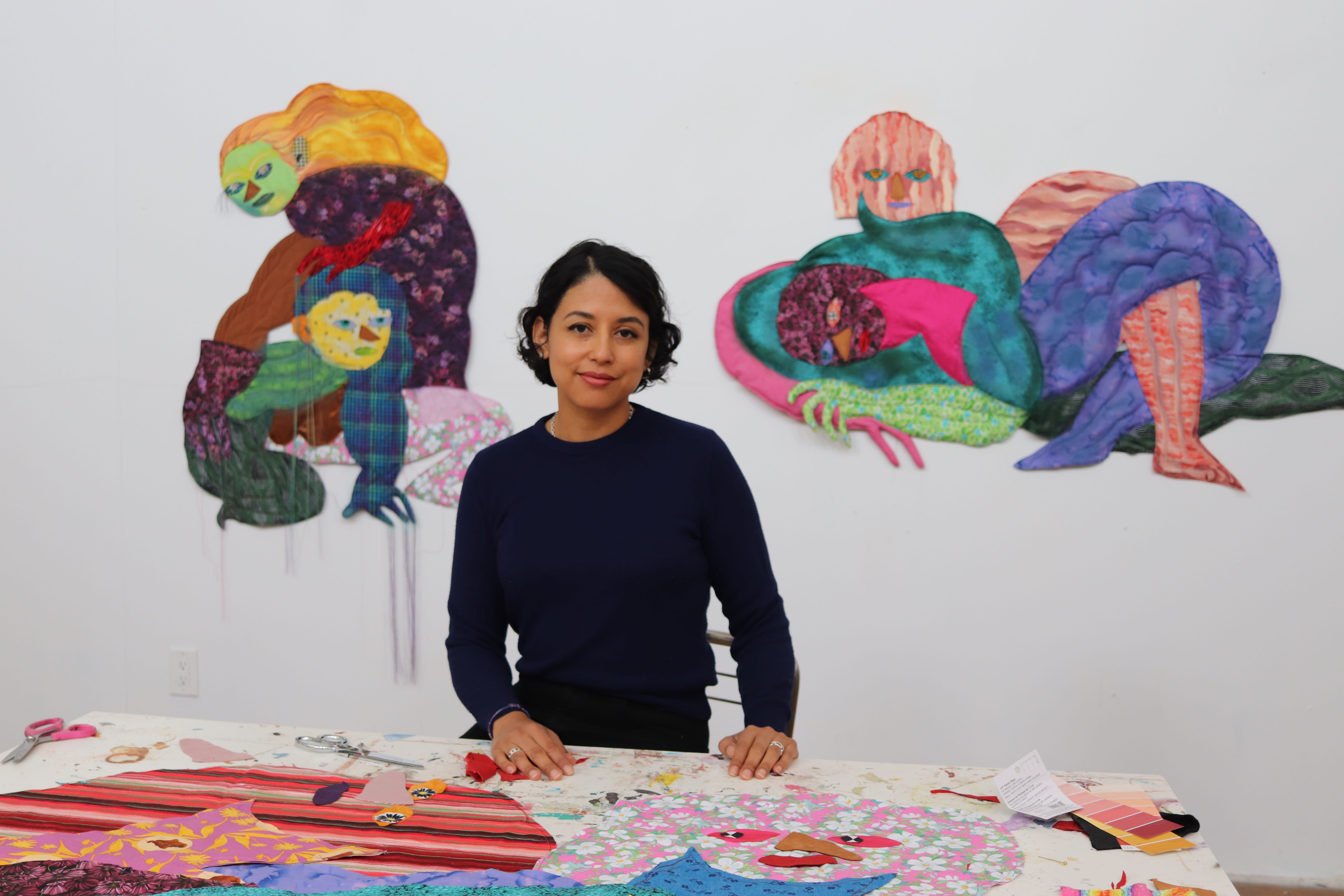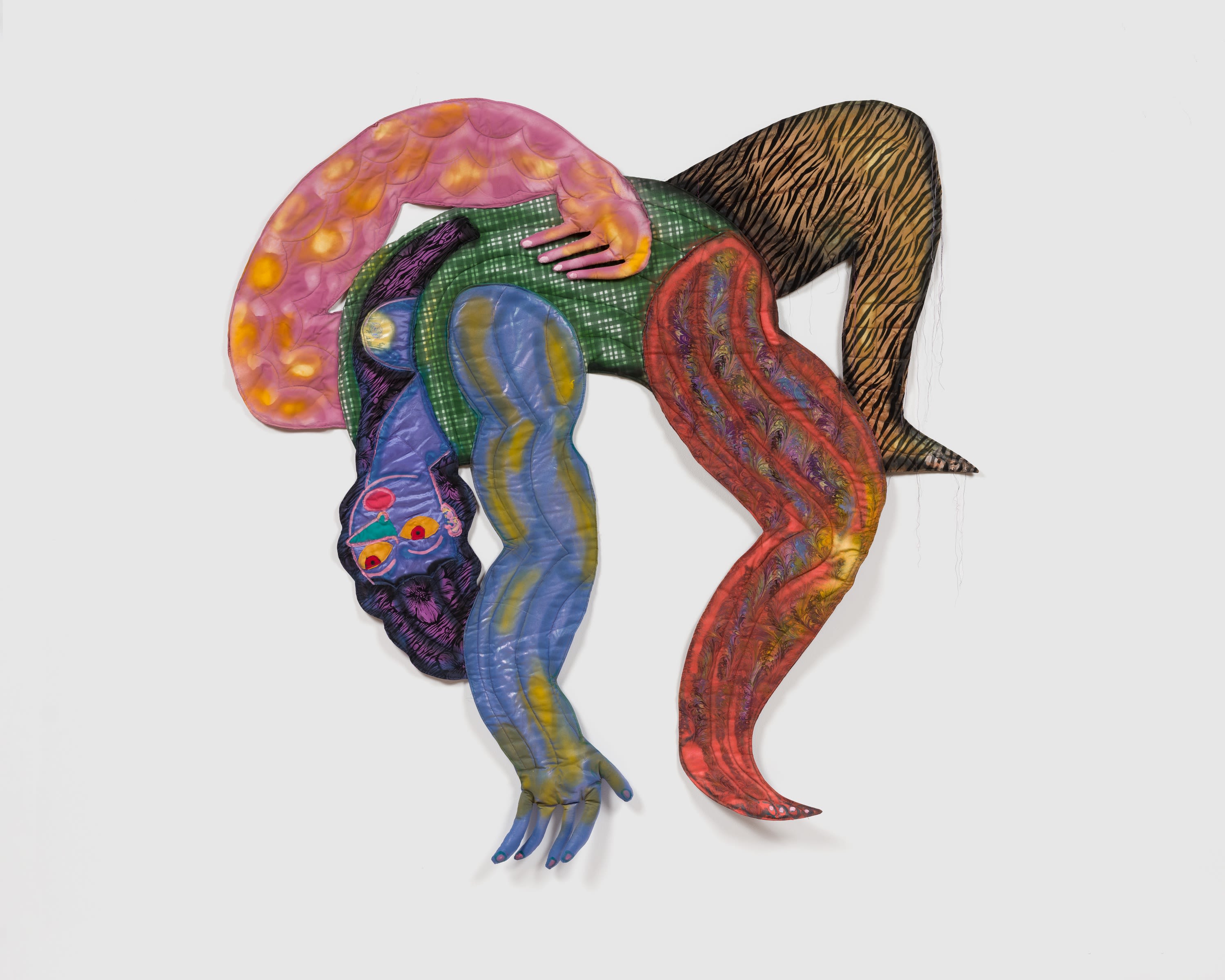Reshaping self-expression with sculptural textiles.
In May, the Oakland, California–based artist Maria A. Guzmán Capron will present a solo exhibition at Shulamit Nazarian in Los Angeles, building on a special relationship with the premier gallery. In 2022, Capron debuted her solo show “Celaje,” and was a part of the gallery’s milestone anniversary group exhibition, “10 YEARS.” The exhibition this spring will build on the artist’s captivating expression of the human experience in vibrant, hand-sewn and painted textiles and wall works.

Installation view, Maria A. Guzmán Capron: Celaje, 2021, November 13, 2021 – January 8, 2022.
Drawing upon a childhood in Milan, teenage years spent in Texas, and adoration for her Colombian and Peruvian heritage, Capron creates otherworldly bodily forms, which sing of the multilayered immigrant experience. Each labor of love creatively investigates class and gender, and fully embraces our dreamlike, inner worlds. Last year, as the 2022 recipient of the San Francisco Museum of Modern Art’s SECA Award, the artist debuted her singular show “Respira Hondo” in a powerful awardee exhibition that is currently on view through May 29.
Whitewall had the opportunity to speak to Capron about the evolution of her unique practice, breaking the boundaries of self-identify with gusto, and celebrating infinite possibilities.
WHITEWALL: As an undergraduate studying painting, how did you first with devirse materials and fabrics?

Maria A. Guzmán Capron, Torbellina, 2021, fabric, thread, batting, latex paint, spray paint, and acrylic paint, 83 x 65 inches, photo by Maddy Mesa, courtesy of the artist and Shulamit Nazarian, Los Angeles.
MARIA A. GUZMÁN CAPRON: I have always loved clothing and the fabrics that make it, but it was during my undergraduate degree that I started incorporating these materials into my work. I started going to thrift stores. I fell in love with the variety of color, pattern, and texture I found there, and I wanted to bring that into my work. These items had an innate way of speaking to notions of class, gender, and cultural identity. I didn’t know how to sew initially, so I would make cutouts from cardboard or plywood and then hot-glue pieces of fabric to them. I wanted these fabrics to play a prominent role in my work, and it was thrilling to create my own process.
WW: How did this grow into your process today? How would you describe your current process and practice?
MAGC: Early on I did learn to use a very basic sewing machine, and I made soft sculptures, wearable masks, installations, costumes for performance. It was in graduate school in San Francisco, with the space and time to focus on my art practice, that my current process really clicked into place. I started to quilt and reintroduce paint and figurative elements into my practice. This formed the basis of my current work.
WW: Your 2022 San Francisco Museum of Modern Art SECA Award Exhibition, currently on view through May 29, 2023, debuts site-specific wall works and abstract portraits on a grand scale. What was the starting point for this process?

MARIA A. GUZMÁN CAPRON, MUCHO MÁS (FOREGROUND), EROS (BACKGROUND), AND LUNA (BACKGROUND) FROM THE INSTALLATION RESPIRA HONDO, SFMOMA. PHOTO: KATHERINE DU TIEL.
MAGC: I wanted to create an exhibition in which all the works came together to summon an intimate, surreal experience. The title is “Respira Hondo.” I have repeated this saying in my head (“Take a deep breath”) as a way to calm down. Take a deep breath, so that I can be clear when I want to communicate something important. I was also thinking of our breath as a way to travel inside our own bodies, to deeper inner worlds. I wanted to make a real connection with this inner world and with the people who will come to experience it.
The first thing you see as you approach the gallery is Mucho Mas, the head and big soft foot of a giantess stepping into our reality. She possesses two sets of pupils in each eye, one to make contact with her visitors and the other to look up at where she came from. The other three works hang on the walls and act as the pillars of this world, each with an intended purpose: Eros to conjure love and care, Danza to emanate joy and passion, and Luna to keep track of and distort time. Respira Hondo is meant to offer something that makes us feel good and a little more ready for everything else in our daily life.
WW: What draws you to the recycled fabrics, defined by others as tacky, exotic, or off-kilter, that you often
MAGC: It started with my early love of clothing as a way to develop and express identity on a daily basis. I love the way Daniel Miller writes about this in “Why Clothing Is Not Superficial.” Every day you create a self and a way to present yourself to others. This idea of continuous identity creation drives my passion for textiles, because I see in them a way of communicating.

Maria A. Guzmán Capron, portrait courtesy of Shulamit Nazarian.
I look for fabrics that encompass a varied vocabulary, and I have very diverse sources as a result. I see this process as representative of many immigrants’ experiences. I need a variety of sources, because that is the only way I will approximate the complexity of a self and its contextual relationships, which in my specific case includes having South American parents (Colombian and Peruvian); being born and living in Italy as a child; living in Colombia as a teenager; and now living in America for 25 years.
It took a long time to understand how people saw me: that I did not look Italian, didn’t sound Colombian or Peruvian, and didn’t interact with people the way Americans do. All of these relationships to places and people have kept trying to define who I am. Sometimes I let all of this wash over me and find comfort in these definitions and I embrace the familiarity of my Latinx identity, my femme identity, and others. I become what people want me to be because it is easier. But it is also restrictive, so at other times I feel like a wild beast in a cage.
WW: You have referred to your figures as “beyond-human characters, performing an otherworldly femininity,” which reflect your own journey as well as that of the immigrant, Latinx community. Can you describe the intention and inspiration behind employing this “hot alien” metaphor/aesthetic to your work?

Maria A. Guzmán Capron, Delirio, 2022. Fabric, thread, batting, stuffing, spray paint and acrylic paint. 62 1/2 x 59 in. COURTESY OF THE ARTIST AND SHULAMIT NAZARIAN, LOS ANGELES.
MAGC: I think this idea first originated when I was not yes a U.S. citizen and I had a little green card that called me an alien. At the time I found it humorous because it made me think of the quirky and bulbous E.T., but I didn’t have another planet to go home to. Being defined as an alien and as a noncitizen is meant to limit the ability of a person to participate in society and to make that person less. As a person from many places and cultures, I am not less.
The hot alien, beyond human, femme-plus persona is meant to take power back. Their hotness—a reference to the Latina femme-fatale stereotype, curvy, loud, and colorful—is meant to seduce and maybe tempt you to do something “naughty,” like support immigrant, trans, and women’s rights. It is about taking the gaze that makes you “other” to open worlds of infinite possibility. The characters I portray are muscular, masculine, and feminine; they are tender, sexy, and flirtatious; they can stretch and bend their bodies without limits; and, in all that they celebrate, I find myself and create a place in which I can be all of it and more.


